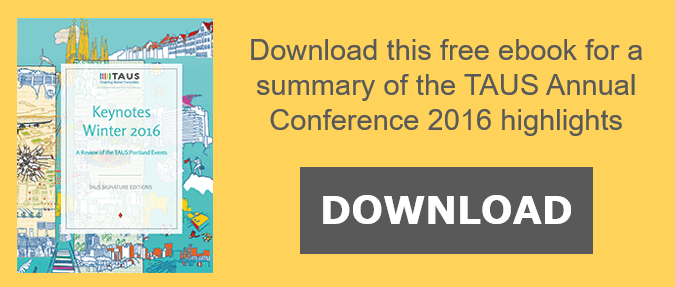 During the TAUS Annual Conference 2016 in October, Eric Bailey, Group Engineering Manager for the Global Service and Experiences team within Office at Microsoft, will host the session 'To Share Or Not To Share'? This blog post is written in preparation for this session.
During the TAUS Annual Conference 2016 in October, Eric Bailey, Group Engineering Manager for the Global Service and Experiences team within Office at Microsoft, will host the session 'To Share Or Not To Share'? This blog post is written in preparation for this session.
In the general scheme of things, the localization industry is relatively small, the challenges associated with the process of localization are well understood and consistent, regardless of which companies are involved. While there are a couple of possible exceptions, most of us would agree that the tools and infrastructure that we invest in are not, in the long term, a strategic differentiating factor for our core businesses. However, there can be considerable opportunity cost associated with developing unique solutions for our individual businesses. There is considerable advantage to be won when we can collaborate in an open source model to reduce this opportunity cost.
The core principles of open source include “transparency”, “participation”, and “collaboration”. Some examples of localization and translation open source and community efforts are Resource Static Analysis, XLiff 2.0, Open Authoring / Open Localization, Dynamic Quality Framework - DQF, Welocalize’s GlobalSight, Okapi, MateCat.
Sharing is not limited to source code. Some additional areas to explore are: 1) Standards in file formats, data exchange APIs and processes, 2) Architecture, like microservices architecture and workflow management, 3) Data: translation memories, machine learning models and quality measures, 4) Ideas like Machine Linguistic Assessment, Resource Streaming and Process improvements.
We are interested in promoting an investigation of and prioritization of potential projects. It would be great to identify some concrete examples of tools that we could collaborate on. This session at the TAUS Annual Conference 2016 aims to explore the appetite for such work across the industry, the identification of possible projects and key contributors. At the very least we could create a forum for leading engineers across to community to recognize opportunity for collaboration and convergence.

3 minute read


